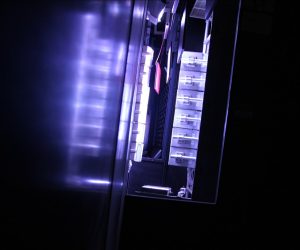Expanding Application area for UV powder coatings

Expanding Application for UV powder coating.
Blends of specific polyesters and epoxy resins have permitted the development of smooth, high-performance finishes for wood, metal, plastic and toner applications.
Wood
Smooth, matte clear coats have been successfully applied on hardwood and on veneered composite board, such as beech, ash and oak. The presence of the epoxy partner in the binder has boosted the chemical resistance of all the coatings tested.
An attractive market segment for the advanced UV powder coating is as a replacement for polyvinyl chloride (PVC) laminates on medium-density fiberboard (MDF) panels for the furniture industry. Combined polyester and epoxy structures have allowed UV powder coating applied on MDF to pass the norm DIN 68861 specification, including chemical, abrasion, scratch and heat resistance.However, the ratio of polyester to epoxy affects the results in accelerated weathering tests; the more polyester in the binder, the less yellowing of the coating. A compromise between UV resistance and chemical resistance or smoothness needs to be found if accelerated weathering tests must be used.
Metal
UV curable powders based on polyester/epoxy blends and applied on metallic substrates have exhibited excellent adhesion and improved corrosion resistance. A copper accelerated salt spray (CASS) test performed according to ASTM B368 to assess the corrosion resistance of clear and white formulations applied on yellow chromated aluminum and on electrolytic chromium coated steel showed good results.
Plastics
When applied as protective clears on PVC tiles for resilient floorings or on sheet molding compound (SMC) panels for OEM applications, the epoxy/polyester combination yields UV powder coating with high levels of flexibility and chemical resistance.Abrasion resistance for matte clear topcoat is good; however, more work is required to achieve high-gloss clear coats.
Toners
A joint development with a toner producer revealed that (meth)acrylated epoxy polyester blends used as binders for colored toners gave the required toner properties after melting and UV curing.
